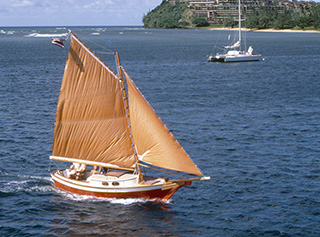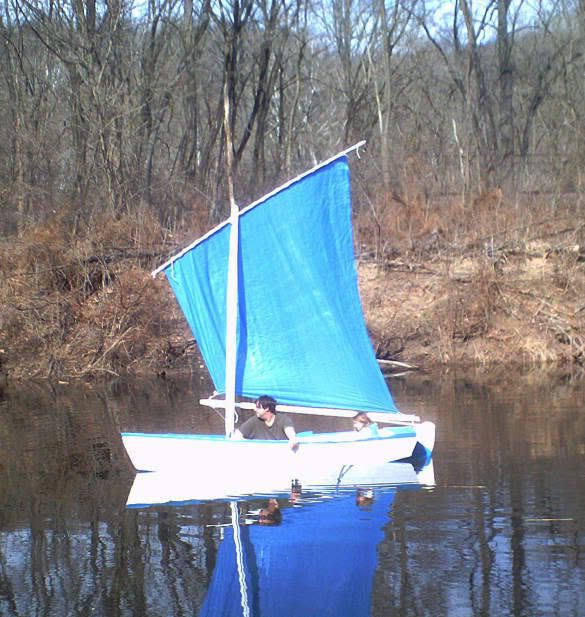The first thing was to pick what general "type" of boat to build. This is a painful process, because you have to stomp on some your own favorite and long-held dreams at this point. We all seem to want that perfect world-cruising sailer with the deep keel and the ability to deliver us to any point on the globe at will. Many try to build this beast - this homewrecking 'dreamboat' - out of any number of designs.
Out of these hundreds or perhaps thousands who start - likely less than a dozen will finish. The rest sit and rot in someone's yard, unfinished - or get sold to someone else as a 'project' boat, not even close to complete.
It's a huge undertaking, and a LOT of expense for a boat we may or may not ever get away on. It didn't take long to come to the conclusion that if I wanted to sail the seas on a self-built boat, it would have to become the central element of all the family's financial planning, plus occupy all of our spare time for many many years - not a good prospect. Building this boat would be, in my mind, about 10x the effort and expense of just buying and refitting one already suited to the purpose, and 100x that of just simply chartering one for that once-in-a-lifetime cruise. So, the "personal pirate ship" went out the window rather quickly.

This isn't happening unless I want to not have a house instead!
This led to the next logical conclusion in the process: Now that we've disposed of the fantasy boat, what about the reality boat? Of course, just because I won't be sailing the seven seas any time soon doesn't mean I've given up on life! I still want the fun of building a boat, but I also want to live in the real world. I'm not getting any younger, so we need to start looking smaller.
After some thinking and some plotting, I came up with a new set of requirements:
20 feet and under, sail being the primary means of propulsion.
Trailerable
A cabin to sleep in
Pretty to look at
Can build it myself at home
A lot of boats suggest themselves. In fact, most people in my situation, after some web browsing, would settle upon Stevenson Projects' "Weekender" for it's simple building, and it's extreme good looks:

Stevenson's "Weekender": Beautiful, but tiny.
I came close to buying the plans for this boat myself. But the more I looked at it, the more my back started to unconsciously ache. I'm 6'4" with a bad back, and this beautiful boat is deceptively small. To one my size, it's more of a largish scale model than an actual craft. There was no way myself, my wife, and our young daughter would ever be comfortable on this boat. And the bigger version they sell plans for, the 'Vacationer' , is largely untested, and frowned upon even by the designers themselves ( for reasons of added expense, difficulty, and building time.)
There were other reasons I chose to avoid the design, but let's move on.
I eventually decided on one that I think suited my family well. This is the Bolger Chebacco.

Sheet-ply hull Chebacco

A Chebacco under sail.
Phil Bolger's Chebacco is a cat-yawl sailboat (which can also have a small outboard attached) of about 20 feet in length. There are two sails: a large mainsail and a smaller mizzen. These are at each end of the boat, leaving the rest of the space to you. It has a nice little cuddy cabin, which you can build a bit bigger if you like.
Best of all, it's roomy enough for me to stretch my legs out in, either in the cockpit, or the cabin. It seems like a wonderful camping boat.
I've read nothing bad about this boat from anyone. It's considered a great boat all around, albeit less well-known than other designs. It's got a shallow draft, lots of space, and is a treat to the eye.
This boat is commonly built in one of two ways, the easier sheet-ply, and the more attractive, yet more difficult lapstrake version. I'm opting for sheet-ply, as that fits my boatbuilding experience at the moment, and appears much cheaper to accomplish. I still think the boat is a beauty in sheet-ply. It has a bit more 'workman-like' aesthetic, like a crab boat turned into a cruiser.
All around, Chebacco seems like the best boat for my buck. My dreams have matured from sailing the high seas on a $250,000, 34 foot boat and trying to keep it afloat, to having a much higher 'fun ratio' building and sailing in this $4000 boat.
Hopefully, Frontier Town Campground will let us sleep on the boat if we pay for a slip-front campsite and a boat slip. If not, we'll set up a tent on the camp site, and sleep on the boat anyway! We'll explore Chincoteague bay in our little boat, and maybe of an evening, head the few miles up to Ocean City, MD and find one of those restaurants with a dock to tie up to while you eat steamed crabs and corn-on-the-cob. Then, our bellies happy but not quite full, we'll head back to the campground slip and take in a banana split while the nightly movie plays in the picnic pavilion.

Frontier Town Family Campground.
And if we ever quit the Land of Winter, and move South to Florida, Chebacco should be an excellent choice for exploring they Keys.
Well, that's enough about the choice of boat, on to the building! The next posts will be about the beginnings of building: site preparation, materials preparation, and emotional preparation.

